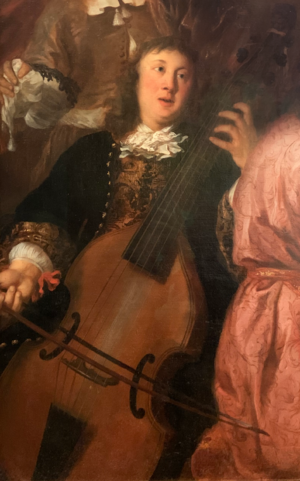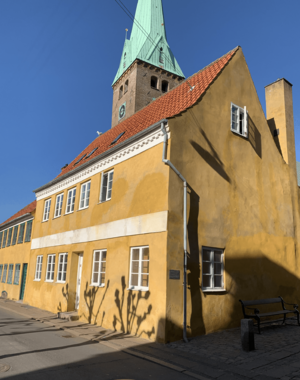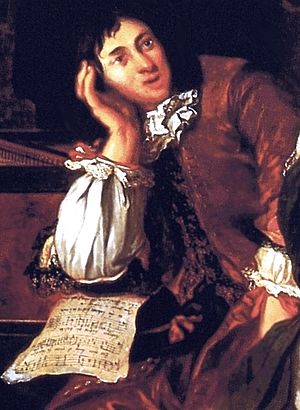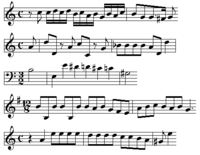Dieterich Buxtehude facts for kids
Quick facts for kids
Dieterich Buxtehude
|
|
|---|---|

The only surviving portrait of Buxtehude, playing a viol, from Musical Company by Johannes Voorhout (1674)
|
|
| Born |
Diderik Hansen Buxtehude
|
| Baptised | 1637 |
| Died | 9 May 1707 (aged 70) |
| Occupation | |
|
Works
|
List of compositions |
| Signature | |
 |
|
Dieterich Buxtehude (born Diderik Hansen Buxtehude; around 1637 – 9 May 1707) was an important organist and composer from the Baroque period. His music style was typical of the North German organ school. Buxtehude's music greatly influenced other famous composers, like Johann Sebastian Bach. Many people consider Buxtehude one of the most important composers of the 1600s.
Contents
Life Story
Early Years in Denmark

Dieterich Buxtehude was likely born as Diderich Buxtehude. His parents were Johannes (Hans Jensen) Buxtehude and Helle Jespersdatter. His father came from Oldesloe, which was part of Denmark at the time.
Experts disagree on exactly when and where Dieterich was born. However, most now believe he was born in 1637 in Helsingborg, Skåne. This area was part of Denmark back then, but it is now part of Sweden. His obituary said he thought of Denmark as his home country. Others think he was born in Oldesloe. Later in his life, he changed his name to the German spelling, Dieterich Buxtehude.
His father, Johannes Buxtehude, was the organist at St. Olaf's church in Helsingør. Dieterich also became an organist. He worked first in Helsingborg (1657–1658), and then in Helsingør (1660–1668). St. Mary's in Helsingør is the only church where Buxtehude worked that still has its original organ.
Moving to Lübeck: Marienkirche
Buxtehude's last job started in 1668 at the Marienkirche in Lübeck. This church had two organs: a large one for big church services and a smaller one for private prayers and funerals. He took over from Franz Tunder. Buxtehude married Tunder's daughter, Anna Margarethe, in 1668. They had seven daughters, but their first daughter died as a baby.
Lübeck was a "free Imperial city." This meant it was independent and gave Buxtehude a lot of freedom in his music career. His independence was a good example for later Baroque composers like George Frideric Handel, Johann Mattheson, Georg Philipp Telemann, and Johann Sebastian Bach.
In 1673, Buxtehude restarted a series of evening music performances called Abendmusik. These concerts were very popular and brought musicians from many places to Lübeck. The Abendmusik concerts continued until 1810.
In 1703, Handel and Mattheson traveled to meet Buxtehude. He was old and ready to retire. He offered his job in Lübeck to them. However, there was a condition: the new organist had to marry his oldest daughter, Anna Margareta. Both Handel and Mattheson turned down the offer and left the next day.
In 1705, a young J.S. Bach, who was only twenty, walked over 400 kilometers (about 250 miles) from Arnstadt to Lübeck. He stayed for almost three months to hear the Abendmusik concerts. Bach wanted to meet Buxtehude, hear him play, and learn more about his musical skills.
His Music
What Kind of Music Did He Write?
Most of Buxtehude's music that we still have today is vocal music (music for singers) and organ music. His organ pieces often focused on church hymns (called chorales) and longer, multi-part forms. He also wrote some chamber music, which is music for a small group of instruments. The only chamber music Buxtehude published during his lifetime was fourteen sonatas.
Sadly, many of Buxtehude's compositions have been lost. For example, we have the words (librettos) for his oratorios (large musical stories), but none of the actual music (scores) survived. This is a shame because his German oratorios might have been models for later works by Bach and Telemann.
Keyboard Music
Preludes and Toccatas
Buxtehude's nineteen organ praeludia (or preludes) are very important. They are considered his most significant contributions to 17th-century music. These pieces switch between free, improvisational parts and strict, structured parts. They often sound like fugues (where a musical idea is repeated and layered). These preludes use the organ's foot pedals a lot.
These preludes, along with pieces by Nicolaus Bruhns, show the best examples of the "north German organ prelude" style. They definitely influenced J.S. Bach, whose own organ preludes and fugues often use similar ideas.
Buxtehude's preludes have many different styles and structures. They usually start with an improvisational section. Then, there's often a fugue, and finally, a closing section. However, this basic plan often changes. For example, some pieces include a full chaconne (a type of repeating bass pattern).
The fugues in his preludes usually have four parts and use the organ pedals a lot. The main musical ideas (subjects) are usually medium length. Sometimes, the fugues end by slowly changing into a free-sounding section, as you can see in Example 4.
Buxtehude also wrote other pieces called toccata or praeambulum. These are similar to his praeludia in how they are built and the techniques used. One famous piece is BuxWV 146, which is in the unusual key of F-sharp minor. It's thought that Buxtehude wrote this piece for himself and his own organ, which he tuned in a special way.
Chorale Settings
Buxtehude wrote over 40 surviving chorale settings. These are some of the most important pieces of this type from the 1600s. Chorales are church hymns. His settings include chorale variations, chorale fantasias, and chorale preludes.
Most of Buxtehude's chorale preludes are short pieces for four parts. The hymn melody is played in the top part, but it's decorated with many extra notes and ornaments. The other three parts play counterpoint (different melodies that fit together).
The chorale fantasias are longer, more complex pieces. They cover a whole verse of the hymn text. Each part of the hymn is developed separately, creating sections that sound very different from each other. These pieces are similar to Buxtehude's praeludia because they have many contrasting textures. Buxtehude was careful to make sure the music fit the meaning of the words. For example, sad parts of the text might have chromatic (colorful) music, while joyful parts might have fast, dance-like fugues.
Ostinato Works
Buxtehude wrote three important pieces that use an ostinato bass. An ostinato is a musical pattern that repeats over and over again. These pieces are two chaconnes (BuxWV 159–160) and a passacaglia (BuxWV 161). These works were very important for the development of this musical style in northern Germany. They are among Buxtehude's most famous pieces and influenced many composers, especially Bach (whose organ passacaglia was inspired by Buxtehude's) and Johannes Brahms.
Some of his praeludia also use ostinato patterns. For example, the praeludium in C major, BuxWV 137, ends with a short chaconne built on a three-bar repeating pattern in the pedal.
Other Keyboard Works
Buxtehude also wrote other keyboard music that doesn't use the organ pedals. This includes a few canzonas, which are strictly contrapuntal (meaning they have many independent melodies woven together). There are also three pieces called fugues.
He also wrote 19 harpsichord suites and several sets of variations. The suites usually follow a standard pattern of dances: Allemande, Sarabande, Courante, and Gigue. Sometimes a movement is left out, or extra dances are added.
His sets of arias (songs) with variations are quite complex. One piece, BuxWV 250 La Capricciosa, might have even inspired Bach's famous Goldberg Variations. Both pieces have 32 variations and share some similarities in their structure. Bach knew Buxtehude's work and admired him greatly.
Recordings
Available Media
You can find many recordings of Dieterich Buxtehude's music today. His organ works have been recorded by many famous organists, including Ton Koopman and Bernard Foccroulle. His harpsichord music has also been recorded by artists like Simone Stella and Ton Koopman. You can also find recordings of his vocal works, such as his sacred cantatas and the famous Membra Jesu Nostri, performed by groups like the Amsterdam Baroque Orchestra & Choir and The Sixteen.
Images for kids
See also
 In Spanish: Dietrich Buxtehude para niños
In Spanish: Dietrich Buxtehude para niños












